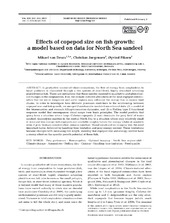| dc.contributor.author | Van Deurs, Mikael | |
| dc.contributor.author | Jørgensen, Christian | |
| dc.contributor.author | Fiksen, Øyvind | |
| dc.date.accessioned | 2016-03-16T11:29:30Z | |
| dc.date.available | 2016-03-16T11:29:30Z | |
| dc.date.issued | 2015-02-03 | |
| dc.Published | Marine Ecology Progress Series 2015, 520:235-243 | eng |
| dc.identifier.issn | 0171-8630 | en_US |
| dc.identifier.uri | http://hdl.handle.net/1956/11680 | |
| dc.description.abstract | In productive marine off-shore ecosystems, the flow of energy from zooplankton to large predators is channeled through a few species of short-lived, highly abundant schooling planktivorous fish. There are indications that these species respond to qualitative and phenological changes in the zooplankton. If so, the climate-induced alterations of the local copepod communities that we see in temperate and arctic regions may influence the energy flux in marine food chains. In order to investigate how different processes contribute to the relationship between copepod size and fish growth, we merged 2 mechanistic models from relevant data: (1) a model of the bioenergetics and stomach filling/evacuation dynamics, and (2) a Holling type II functional response model that encompasses visual range from basic principles. The model predicts that going from a situation where large Calanus copepods (2 mm) dominate the prey field of lesser sandeel Ammodytes marinus in the central North Sea to a situation where only relatively small (1 mm) and less energy-rich copepods are available roughly halves the energy intake of sandeels even if prey biomass concentration remains constant. Visual constraint on foraging was the most important factor, followed by handling time limitation and prey energy content. These limitations became stronger with increasing fish length, showing that copepod size and energy content have a strong effect on the specific growth potential of these fish. | en_US |
| dc.language.iso | eng | eng |
| dc.publisher | Inter-Research Science Center | en_US |
| dc.rights | Attribution CC BY 3.0 | eng |
| dc.rights.uri | http://creativecommons.org/licenses/by/3.0 | eng |
| dc.subject | Prey preference | eng |
| dc.subject | Bioenergetics | eng |
| dc.subject | Optimal foraging | eng |
| dc.subject | North Sea regime-shift | eng |
| dc.subject | Climate change | eng |
| dc.subject | Ammodytes | eng |
| dc.subject | Holling disc | eng |
| dc.subject | Calanus | eng |
| dc.subject | Handling time limitation | eng |
| dc.subject | Food quality | eng |
| dc.title | Effects of copepod size on fish growth: A model based on data for North Sea sandeel | en_US |
| dc.type | Peer reviewed | |
| dc.type | Journal article | |
| dc.date.updated | 2015-12-30T17:03:22Z | |
| dc.description.version | publishedVersion | en_US |
| dc.rights.holder | Copyright the authors 2015 | en_US |
| dc.identifier.doi | https://doi.org/10.3354/meps11092 | |
| dc.identifier.cristin | 1248627 | |
| dc.subject.nsi | VDP::Matematikk og naturvitenskap: 400::Zoologiske og botaniske fag: 480::Økologi: 488 | |
| dc.subject.nsi | VDP::Mathematics and natural scienses: 400::Zoology and botany: 480::Ecology: 488 | |
| dc.subject.nsi | VDP::Matematikk og Naturvitenskap: 400 | en_US |

